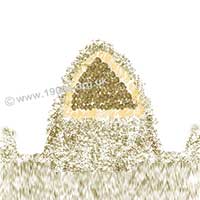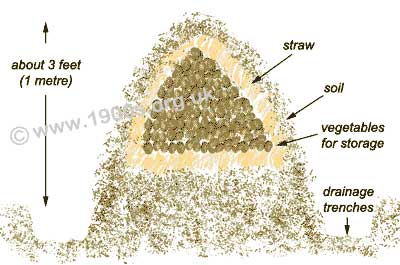How to store root vegetables for later use: clamping

Growing one's own vegetables can lead to a glut. Rather than letting them rot in the ground, they can be preserved for use during the rest of the year using a traditional method, known as clamping. It works for all root vegetables such as potatoes, carrots, parsnips, beetroots, etc. This page describes and illustrates a clamp. It explains how to build one, how it works and how to use the stored vegetables as required.
____
By the webmaster based on discussions with Bill Hogg, Dick Hibberd and Neil Cryer with additional research
Vegetable clamping is an old methods which was particularly widespread during World War Two, when every scrap of land had to be used for growing food to cope with rationing and shortages. Householders even set their gardens aside for the purposed. losing flowers and shrubs in the process. Fridges did not become commonplace until the 1950s and freezers even later and would not have enough space to store a year's supply of potatoes, carrots, parsnips and beetroots, etc.
Why clamping worked
Provided that only sound vegetables were used and all the excess stalks and leaves which could rot were removed, clamping worked well to preserve root vegetables. This was because it:
- Kept the stored vegetables slightly moist so that they did not dry out while keeping out the wet which would have made them rot
- Prevented frost getting to them,
- Prevented the light getting to them.
How to make an old-style vegetable clamp
If possible choose a site that is likely to be reasonably dry, although this is not always possible.

Main sections of a vegetable clamp
Start by digging two parallel trenches and putting the soil in a line between them as shown in the above diagram. The lengths of the trenches must depend of the amount of vegetables to be stored - probably about 15 or 20 feet. In earlier times, men probably had a 'feel' for this, and they could always make the trenches longer if necessary. These trenches are for drainage, and the raised soil is to keep the vegetables above ground level away from ground water and frost.
Spread a layer of straw along the raised area and layer the vegetables on it.
Continue with more layers of vegetables, letting them dry between layers but not dry out. Then top with straw and more soil. Finally leave a small vent in the top of the ridge, to allow air to have some limited air circulation.
The resulting clamp should be of pyramid cross section and about a metre high. This size is important because the moist straw causes a form of decomposition to take place which provides enough warmth to keep the clamp from freezing even in cold winters. If the clamp is too small, it does not keep sufficiently warm and if it is too large, the vegetables get too hot and start to rot. So larger clamps need to be longer rather than wider.
I am told that clamping vegetables was a task given to enemy prisoners of war during World War Two.
How to use the stored vegetables
Root crops keep for most of the winter in a vegetable clamp, and those which aren't quite fit for human consumption when the clamp is opened can be fed to cows or pigs.
The vegetables are removed as required, starting from one end of the clamp and working towards the other end. This maintains the optimum cross-section of the clamp and keeps the remainder of the vegetables in best condition.
The vegetables can be prepared and cooked in the usual way.
| sources | webmaster | contact |
Text and images are copyright
If you can add anything to this page or provide a photo, please contact me.



